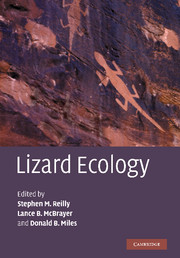Book contents
- Frontmatter
- Contents
- List of contributors
- Preface
- Historical introduction: on widely foraging for Kalahari lizards
- I Organismal patterns of variation with foraging mode
- 1 Movement patterns in lizards: measurement, modality, and behavioral correlates
- 2 Morphology, performance, and foraging mode
- 3 Physiological correlates of lizard foraging mode
- 4 Lizard energetics and the sit-and-wait vs. wide-foraging paradigm
- 5 Feeding ecology in the natural world
- 6 Why is intraspecific niche partitioning more common in snakes than in lizards?
- 7 Herbivory and foraging mode in lizards
- 8 Lizard chemical senses, chemosensory behavior, and foraging mode
- 9 Patterns of head shape variation in lizards: morphological correlates of foraging mode
- 10 Prey capture and prey processing behavior and the evolution of lingual and sensory characteristics: divergences and convergences in lizard feeding biology
- 11 The meaning and consequences of foraging mode in snakes
- II Environmental influences on foraging mode
- Index
- References
9 - Patterns of head shape variation in lizards: morphological correlates of foraging mode
Published online by Cambridge University Press: 04 August 2010
- Frontmatter
- Contents
- List of contributors
- Preface
- Historical introduction: on widely foraging for Kalahari lizards
- I Organismal patterns of variation with foraging mode
- 1 Movement patterns in lizards: measurement, modality, and behavioral correlates
- 2 Morphology, performance, and foraging mode
- 3 Physiological correlates of lizard foraging mode
- 4 Lizard energetics and the sit-and-wait vs. wide-foraging paradigm
- 5 Feeding ecology in the natural world
- 6 Why is intraspecific niche partitioning more common in snakes than in lizards?
- 7 Herbivory and foraging mode in lizards
- 8 Lizard chemical senses, chemosensory behavior, and foraging mode
- 9 Patterns of head shape variation in lizards: morphological correlates of foraging mode
- 10 Prey capture and prey processing behavior and the evolution of lingual and sensory characteristics: divergences and convergences in lizard feeding biology
- 11 The meaning and consequences of foraging mode in snakes
- II Environmental influences on foraging mode
- Index
- References
Summary
Introduction
The relationship between cranial morphology, diet, and feeding performance has been explored in most vertebrate classes. In fact, key biomechanical elements and regions of the skull are known to be associated with various prey types in a wide range of species (Radinsky, 1981; Kiltie, 1982; Lauder, 1991; Zweers et al., 1994; Perez-Barberia and Gordon, 1999). Numerous examples in teleosts have linked form, function, and diet (Lauder, 1991; Turingan et al., 1995; Wainwright, 1996); in birds, beak morphology and lever mechanics have been correlated with various dietary patterns (Beecher, 1962; James, 1982; Barbosa and Moreno, 1999). In mammals, the rostrum (snout) often becomes narrower and incisor tooth structure changes as dietary selectivity increases (Radinsky, 1981; Solounias, 1988; Gordon and Illius, 1994; Biknevicius, 1996).
In lizards (non-ophidian squamates), there are relatively few quantitative and comparative studies relating diet to skull morphology, especially with regard to foraging modes (McBrayer, 2004). Classic works provide descriptions of lizard skull and muscle morphology (see, for example, Haas, 1973; Gomes, 1974). Some functional morphological studies have detailed particularly interesting forms such as the outgroup to lizards, Sphenodon (Gorniak et al., 1982), durophagous species (Wineski and Gans, 1984; Gans et al., 1985; Gans and De Vree, 1986, 1987), carnivorous species (Smith, 1982, 1984; Throckmorton and Saubert, 1982), ovophagous species (Herrel et al., 1997b), and herbivorous species (Throckmorton, 1976, 1978, 1980; Herrel and De Vree, 1999; Herrel et al., 1999a).
- Type
- Chapter
- Information
- Lizard Ecology , pp. 271 - 301Publisher: Cambridge University PressPrint publication year: 2007
References
- 16
- Cited by

